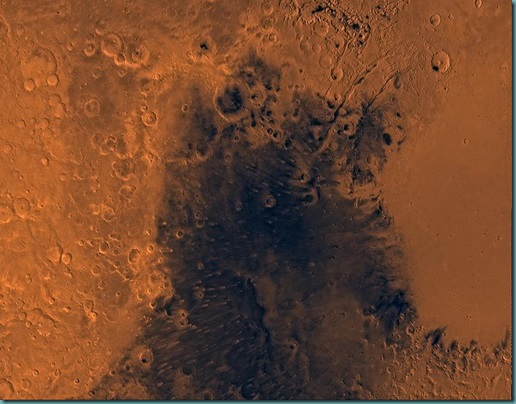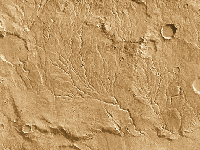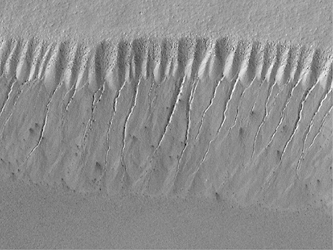Mars

Credit HST - Click on the image.
Sorry, Bruno, not you.
Mars has captured the imagination of poets and scientists for centuries. The similarities between the Earth and Mars tempts us to wonder if Mars could harbor life. Here are the facts:
Mars is about half the size of the Earth and has a much thinner atmosphere composed mainly of carbon dioxide (CO2). It has a rotation period which is similar to the Earth (24 hours, 37 minutes), a tilt similar to the Earth (25 degrees), and ice caps which shrink and grow with the seasons. In 1877, Italian astronomer Schiaparelli was mapping the surface of Mars and envisioned channels on Mars and called them "canali." This was mistranslated into "canals" implying some intelligent life constructed them (it didn't help that the Suez Canal was just completed in 1869). This idea was perpetuated by American astronomer, Percival Lowell, who claimed to see the same thing. This was, in fact, an optical illusion because modern telescopes (with better resolving power) revealed that canals do not exist.
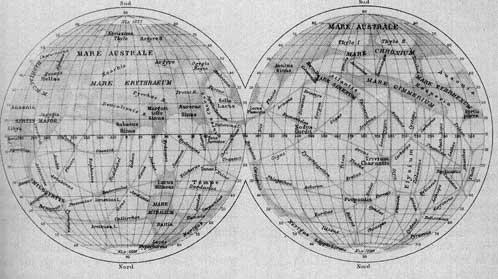
Schiaparelli drawing Credit NASA
Imaginations took over when H. G. Wells wrote The War of the Worlds in 1898. This planet had an advanced life form, capable of great technological feats. They lacked the liquid water needed for life so they built world wide aqueducts which would transport precious water from the polar region to the Martian cities closer to the equator. Are they looking at the Earth with envy? After all, 71% of its surface is covered by water. On Halloween in 1938, Orson Welles did such a realistic version of the novel over the radio that panic broke out across the country as listeners thought an invasion from Mars was really occurring. In 1952, the movie version scared the *&*^%$#* out of me as well, .... and I fell in love with Mars for life.

From the 1952 movie version. How can Steven Spielberg
top this?
The Viking Landers revealed a much different Mars. Barren, dry, cold, and lifeless .... Mars appeared to be a pile of rusty rocks.
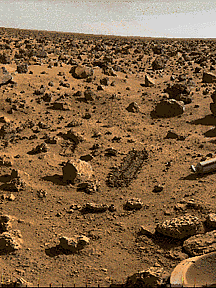
Credit NASA - Viking landing site
Things got interesting when high resolution images from the Martian Global Surveyor came streaming in. They revealed to us that Mars had an interesting past. Astronomers believe Mars is currently a geologically inactive (dead) planet with no evidence of liquid water (on the surface), no active volcanoes, no marching Martian armies.
Mars - the big
picture
Mars has two hemispheres which are radically different. The Northern hemisphere is relatively flat and low. The Southern hemisphere is elevated (on average about 6 km above the northern flat hemisphere), and rough, ... with lots of impacts sites. One small section of Mars is an elevated plateau known as the Tharsis Bulge. This is shown on the map below as the area in red
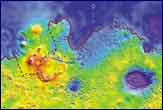 Low areas are indicated in
blue. Notice Hellas Basin ... a huge ancient impact site in the southern
hemisphere and the lowest point on the surface.
Low areas are indicated in
blue. Notice Hellas Basin ... a huge ancient impact site in the southern
hemisphere and the lowest point on the surface.
Click here to see some rotating images of Mars.
About a dozen huge, inactive shield volcanoes are found on the Tharsis Bulge. The largest is Olympus Mons which is 3 times higher than Mount Everest and has a base about the area of Wisconsin. Now that is BIG ... the biggest in the solar system!
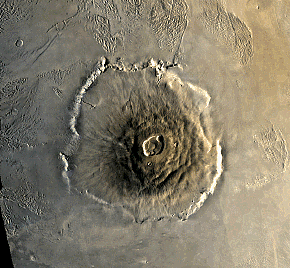
Olympus Mons (credit NASA)
Next to the volcanoes (and part of the Tharsis Bulge), is a monster canyon - Valles Marineris (which is several times the width and depth of the Grand Canyon and as long as the entire US)
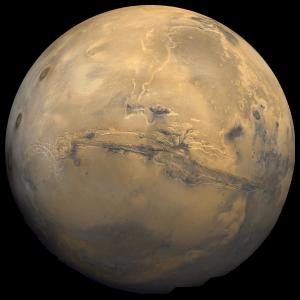
A big scar - Valles Marineris
Credit JPL
It is believed that the Tharsis Bulge was produced billions of years ago as internal heat forced this area upward. This represented an early "hot spot" on Mars. The Earth has "hot spots" as well. The most well known are the Hawaiian Islands. This earthly hot spot is not associated with a plate boundary and all those huge volcanoes are a result of magma in the mantle moving to the Earth's surface. That is, the volcanoes are where the interior heat escapes to the surface by punching a hole in the crust. The Hawaiian Islands are actually a long chain of islands that formed because the crust moves relative to the hot spot. But on Mars, there is no evidence of plate tectonics or plate motion. Since that didn't happen on Mars, the volcanoes just kept on getting bigger and bigger. Valles Marineris formed when the crust was pushed up, representing a global "stretch mark" on the surface (like when you squeeze a balloon and part of it bulges out). It was widened by the action of water that once flowed on the surface.
There is a web site that you might be interested in.
Microsoft funded a place (http://www.worldwidetelescope.org/webclient/)
that lets you see all kinds of things relevant to the class (and much more).
If you go there and use the lower left option to “Look At:”
and choose Planet and then choose Mars as the target in the
adjacent menu, you can spin Mars around and see all the features we have
been learning. If you zoom in, the resolution changes and gets more and more
detailed. Even better, if
you “Look At:” and choose panorama, the adjacent menu has a
ton of rover landing site images in 360 degrees.
It is like being on Mars!
Not any information there, but the visuals are spectacular.
We hope to learn more about the interior of Mars when the InSight Lander attempts to
measure "Marsquakes" (seismographic
activity) in late 2018. Geologists hope to use the data to map the interior
layers of Mars as well as current activity below the Martian surface. The
mission may help answer questions about how the planet formed. Update
2020: Scientists expected to find a "marsquake" only about once a year.
They are being recorded almost daily! This needs more study.
Unfortunately, a mole intended to be drilled about 6 meters into the surface
must have hit something very resistant and currently NOT at the depth
expected.
Update 2021: The data is in and we now know a lot more
about the interior of Mars. The interior of Mars has a layered
structure (like the Earth) with a crust, mantle, and core. The crust is thin
with embedded sub-layers in it. The lithosphere (rocky part, which
includes the upper mantle, is much thicker than Earth. This could
explain why there is no plate tectonics observed on Mars. The core is
larger than expected and liquid. Why that doesn't produce a magnetic
field is still a puzzle. Read
here for more details.
The thin, turbulent
atmosphere
The very first spacecraft to orbit Mars was Mariner 9 in 1971. When it arrived there and started taking pictures, astronomers quickly realized that something very unusual was going on at the surface .... a global dust storm. This seemed unlikely because the Martian atmosphere is very thin. Since then, many other huge dust storms have been recorded, usually when the seasons change from winter to summer. Part of the answer comes from polar ice caps which also grow and shrink with the seasons. During the Martian winter, a vast amount of the atmosphere is locked up as water ice and CO2 ice (or dry ice) at the pole. As spring approaches, a lot of these gasses are released into the atmosphere, creating global winds which blow toward the equatorial regions and picking up surface dust in the process. Sand dunes pile up in one location and expose darker (basaltic) bedrock in other places, ... changing the way light reflects off the surface. This contrast produces a shifting pattern of lighter and darker areas on Mars. Early astronomers mistook this changing pattern as vegetation, making the case for Martian life stronger.
|
Global winds kick up sand and erode the surface. Credit NASA |
The surface changes as the winds
blow surface dust around. Credit NASA
|
Zooming in closer, the orbiters observed several impact sites.
Then the shocker .... evidence that water once flowed on the surface!!!!
|
A network of dried up riverbeds? Credit NASA Click on the image for a closer look. |
|
Outflow Channels on Mars show a period when massive amounts of water was suddenly released (like when a dam breaks) and instantly changes its surface. This was likely an underground liquid source.
By studying the occurrence of overlying impact craters, scientists have concluded that the networks of river beds are extremely ancient - several billion years old.
Water on Mars?
Liquid water cannot exist on the surface of Mars today for very long. Oddly enough, even though it is extremely cold on the surface of Mars (average surface temperature is around minus 80 degrees Fahrenheit), a glass of water would boil away in a short time! Why? It has to do with the low surface pressure. Water can only exist as a solid (ice) or as a vapor in the atmosphere. The images clearly show some action of a liquid and water represents the best candidate. This was why NASA sent the Spirit, Opportunity, and Curiosity rovers to Mars, ... to find evidence of liquid water which might have existed on the surface in the distant past. The results are in .... liquid water did once exist on the surface of Mars. The clues come from many different observations.
· The Phoenix lander discovered water ice just below the surface (away from the polar caps).
· Opportunity discovered the mineral hematite (basically rust) in sedimentary layers. This mineral forms in the presence of water on Earth.
· Another mineral, jarosite, was also found which forms in the presence of acidic water on Earth.
· Deposits of several minerals (including gypsum and sulfur) have been found which (on Earth) form when water evaporates ... leaving behind these insoluble mineral deposits.
· Close-up images from Opportunity reveal crossbedding patterns in sedimentary layers ... suggesting they were formed by gently flowing salt water.
· Strong evidence of groundwater came from the discovery of Vugs ... small cavities in rock which form when percolating ground water dissolves minerals (like gypsum).
· The Curiosity rover has actually found that the soil contains 2% water (by weight). The soil releases the water when heated.
· Sedimentary rocks and sedimentary strata have been detected on Mars.
This forces us to ask some additional questions. If liquid water once existed on Mars, where did it go? How much was there? What happened to the atmosphere (it had to be much denser if liquid water was there in the past)? Water is essential to all life on the Earth. Was there life on Mars when it, too, had liquid water? Could life still exist on Mars?
Some scientists believe that the entire Northern Hemisphere (lowlands) may have played host to a huge shallow ocean. This area is younger (by the low number of impact craters) versus the heavily cratered southern highlands. Mars did have a much warmer, thicker, greenhouse atmosphere several billion years ago. The volcanoes on the Tharsis Bulge would have pumped huge quantities of CO2 into the atmosphere, ... making it warmer and denser. Then Mars died - geologically. Volcanic activity ceased because the interior can cool quicker on a planet only half the size the Earth. No new gases were being added to the atmosphere as a result. (Note: Those inactive volcanoes may simply be dormant. The low number impact craters found on the last outflow suggest the last volcanic activity was relatively recent.) In addition, being only half the size of Earth and only 11% its mass, the lower surface gravity would have made it easier for gasses to escape into space. This activity was accelerated because Mars has no magnetic field, making it easier for solar activity (solar wind) to attack and diminish the atmosphere. The surface of Mars today is currently being blasted by ultraviolet radiation from the sun (since it has no protective ozone layer). This provides an extremely hostile environment for life as we know it.
There is very little water vapor in the thin Martian atmosphere. Water that didn't escape into space may have seeped into the ground. If so, there may be lots of frozen water in the soil (permafrost). This has been verified by the orbiting Odyssey spacecraft which has instruments able to directly detect water ice deep below the surface of Mars. Going deeper, liquid water could easily exist in the form of groundwater (because it would be warmer and under much higher pressure). If life found a way to exist on Mars, could it thrive deep underground? Bacterial life has been found under similar conditions on the Earth.
In September 2015, NASA announced that images from the Mars Reconnaissance Orbiter detected water flowing down steep slopes in the form of (warm) seasonal "dark streaks". The water then quickly evaporates. It is unclear what the source of the water is. My guess is it percolates up from a deep aquifer ... much like you find in an artesian well. This liquid water is salty (mixed with hydrated minerals known as perchlorates) which act like antifreeze ... allowing the water to remain in the liquid state for a short time. This raises the hope that microbial life may exist on Mars (although some argue this water is too briny to support life). Learn more here.
It gets better! In July 2018, scientists suggested that there may be liquid water beneath the southern polar ice cap of Mars. The 12-mile-long lake (a mile beneath the ice) was detected by radar echoes from an orbiting spacecraft. This lake would be similar to Lake Vostok under Antarctica which is hosts over 3,500 species. This raises hope that life could still survive on Mars. Read more here. Update: Darn, that lake maybe isn't a lake at all, but rather, just layers of frozen clay. Rats, I wanted to go scuba diving on Mars!!!! Ohhhh ... update to the update. Maybe I can go scuba diving on Mars. This 2022 study shows independent evidence of liquid water under the southern ice cap on Mars by studying the shape of the ice at the surface. Interesting!
One last (interesting) thing has been detected on Mars. On several occasions, natural gas (methane) has been detected on Mars. It appears to come in "burps" ... the latest from the Gale crater detected by the Curiosity rover and the European Trace Gas Orbiter in 2016. Update: It happened again in 2019. Why is this interesting? Methane, on Earth, is produced by microbes. It has not been determined if the source of these methane burps is from life or not but the mere presence of it adds to the mystery ... does life exist on Mars?
Marian Meteorites
We may have to wait until we can explore the surface and return rocks to Earth before we settle the question about life on Mars. However, things got a bit more interesting when some scientists explored a meteorite believed to originate from Mars. A small group of meteorites (known as SNC meteorites) have been found (a few hundred have been identified on Earth). These meteorites contain chambers of gas bubbles which match the Martian atmosphere, do not date to 4.6 billion years (as is the case with the vast majority of meteorites), and have isotopic chemistry similar to rocks studied on Mars. We already have pieces of Mars on Earth! How did they get here? On at least three different occasions, an asteroid or comet smashed into Mars, .... blasting bits of the surface into space. After drifting in space, some of these pieces of Mars eventually landed on the Earth as a meteorite. One of the SNC meteorites, ALH84001, dates to 4.5 billion years and immediately intrigued scientists when they scanned sections with a microscope. This is what they found:

This is a globule of carbon. Could this be the fossil of a Martian organism? Scientists have offered ways to produce these structures with inorganic processes, but the question "was this alive?" is still unresolved. As long as we are speculating, let me offer this interesting addition. Suppose we eventually go to Mars and find that life still exists. How would we know if there is a common ancestry? Easy! See if it uses DNA to replicate. The chemistry of all life on Earth has a common code. Although nature could have found many, many other ways to code life, all life forms on Earth use the same mechanism (of course the structure of DNA is different for each species, ... but the code mechanism is the same for all life on Earth). A good analogy is if there were only Apple computers on Earth and all software (life) was written for them. Now we go to Mars and we find there are are only PC's and all the software (Martian life) is written for them. However, if a Martian life form uses DNA (same computer), it surely has a common ancestry with life on Earth. How is it possible to have a common ancestry? A hypothesis (known as panspermia) suggests that transportation of life from one planet to another is possible by hitch-hiking on comets or meteors. Suppose a rock is blasted off the early Earth and the rock has a few bacteria buried inside. They go dormant until the day they land in a shallow Martian sea and reproduce. Think about this mind blowing possibility! Imagine bacteria that originated on Mars was blasted off the surface on a rock, and fell on Earth. They thrived, evolved, and 3˝ billion years later .... we are the Martians! Wow.
©Jim Mihal 2004, 2014, 2018, 2020, 2021 - all rights reserved
